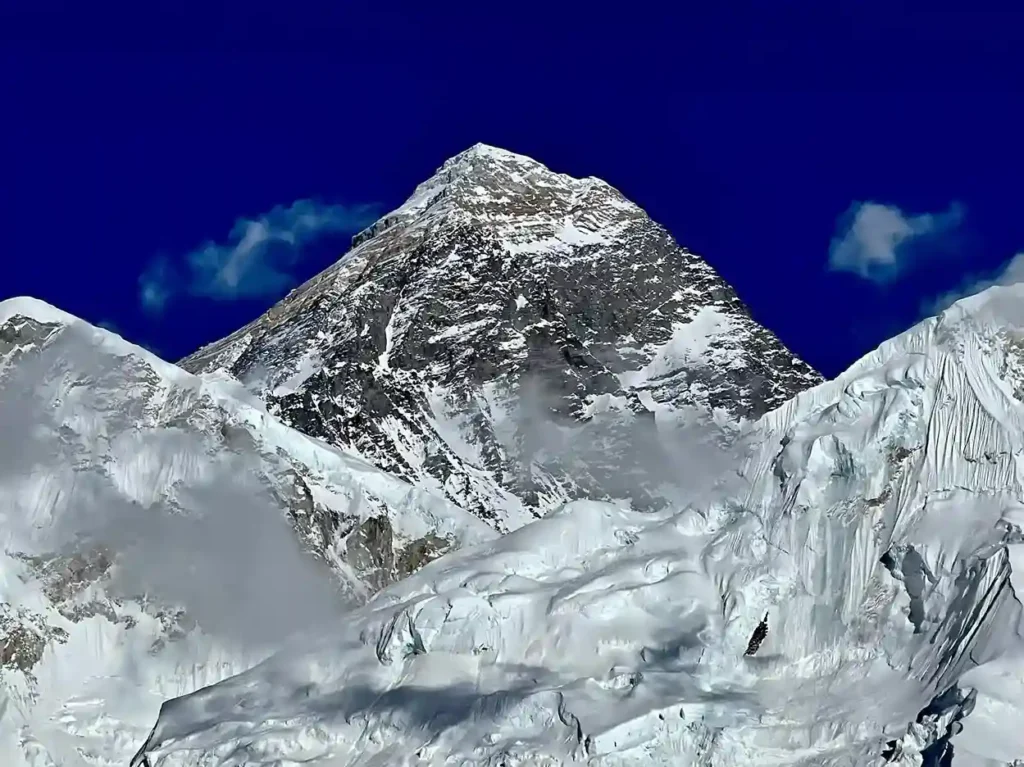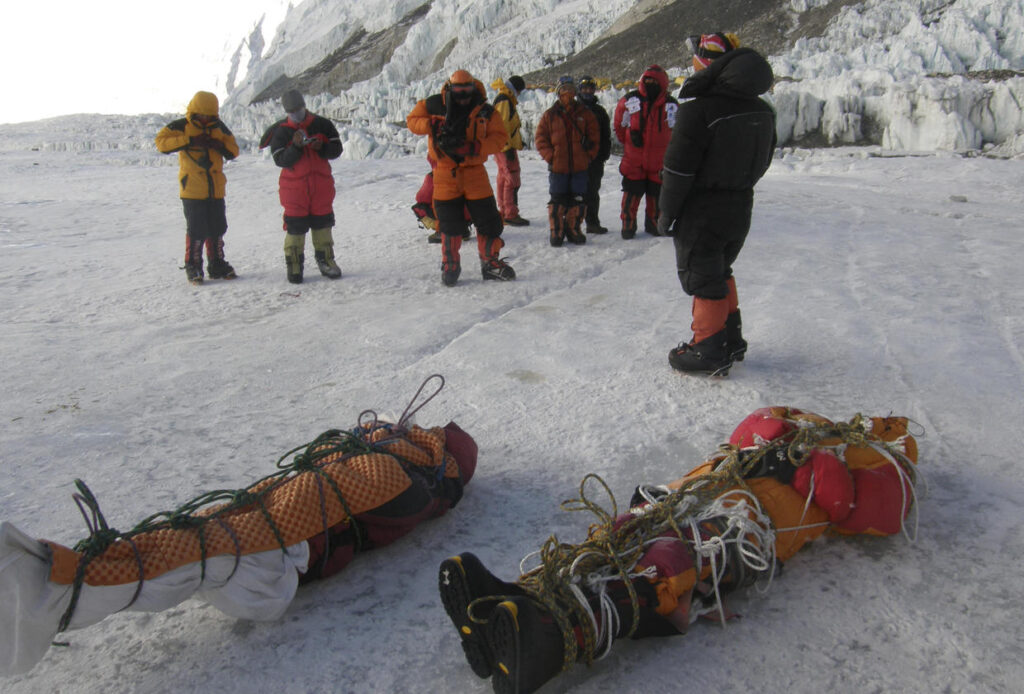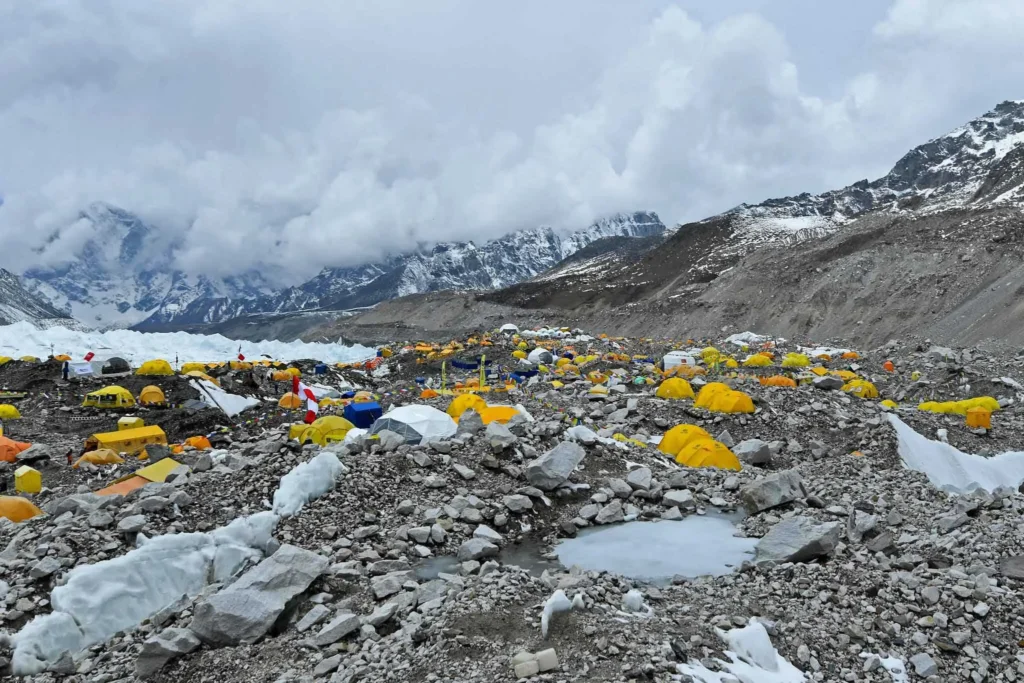The climbing of Mount Everest is considered to be one of the most intimidating tasks or perhaps daring quests that attract people from every corner of the earth. However, this is a big risk and should not be considered without serious thinking.
At altitude, severe oxygen deprivation occurs with the “Death Zone” above 8,000 meters (26,247 feet), since the air pressure at that height is substantially less than that at sea level.
This can result in acute mountain sickness, HAPE, and HACE life-threatening conditions that require immediate treatment. The terrain itself is treacherous with avalanches and crevasses, especially in locations such as the Khumbu Icefall, which is known for its unstable ice formations and frequent snow slides.
Besides, the risks of climbing Everest are multiplied by psychological factors. One very important case, so-called “summit fever,” is when climbers have a partial obsession with the summit, which blinds them to their own physical limitations and safety considerations. It results in poor decisions at some critical point in time.

This climb often involves teams moving under hazardous conditions while managing their time, so they should not descend in the dark or during poor weather. Physical challenges combined with mental strain make climbing Everest a matter not only of endurance but also of judgment. Unfortunately, many climbers have died while descending after successful summits due to exhaustion and altitude-related sicknesses.
Death Rate on Mount Everest
Many people ask What Is The Death Rate Of Mt Everest? Climbing Mount Everest is dangerous; the death toll is indicative of these risks. Recent statistics, although highly reduced over time, indicate that over 340 climbers have lost their lives on the mountain.
This is a drop from the present Mount Everest Fatality Rate of 0.9% to 1% for climbers who venture above base camp, credited in large part to improved climbing gear, better forecasting of weather conditions, and more organized commercial expeditions that provide support and guidance.
In fact, between 2000 and 2019, the average death number was about 3.2 annually, but 2023 turned out to be a really bad year, with 17 fatalities recorded on the mountain.
Mount Everest Death Rate 2024
Due to the fact that the primary season for climbing falls in the spring period of the year, for 2024, exact figures on fatalities cannot be provided. However, early reports suggest that for the coming year, safety and control are of great importance. Nepalese administration is likely to employ more stringent rules on permits to be issued and experience to be gained by climbers prior to attempting such dangerous expeditions.
Discussions related to increasing permit fees have even been considered as an option to control crowding and provide safety measures. Overall deaths on Everest have gone up and down over time, yet remain a key concern among climbers and officials alike. For now, the climbing world remains ever vigilant in regard to conditions and trends as they prepare for another season on the world’s highest peak.
Mt. Everest death toll 2023
It was noted that in the year 2023, Mount Everest became the most lethal season for the climbers as of the 20 deaths of the climbers were confirmed out of the many. It showed that 17 people were killed at the beginning of the disaster, but after receiving information from the Himalayan Database and Nepalese authorities, the number of victims grew because of more detailed information. The causes of death varied, with many attributed to altitude sickness, falls, and accidents in the treacherous Khumbu Icefall.
Notably, the season saw a record number of permits issued-478 for 47 different teams, resulting in nearly 600 summits. This boom was not without its criticism; however, many complained of overcrowding and the experience levels of most participants. The high volume of traffic combined with poor weather led to the deaths, and experts speculated that climate change could be affecting the weather on the mountain, causing conditions to be unlike what has been experienced in years past.
Mount Everest Death Rate by Year
- 1953: Hillary and Tenzing Norgay became the first people to successfully ascend the mountain. As for the loss of life we had on this expedition, there were no martyrs or causalities recorded.
- 1970s: At least 12 deaths were reported during this decade; however, attempts were more in number this decade.
- 1980s: Yet many of them tried the top, and about 30 of them died in the decade.
- The 1990s: This increased to some 40 deaths; the worst was the 1996 calamity, where climbers perished in a storm.
- 2000-2009: It may cause about 50 people to die in this decade. The numbers in 2006 and 2008 were different and showed the maximum death dropping and avalanches.
- 2010-2019: The total of 10 years was 72, which means there were, on average, 7.2 instances in which a person died annually. In terms of the number of doses, 18 deaths were recorded in the year 2015 from a single avalanche due to a big earthquake.
- 2020: There were few expeditions due to the outbreak of the pandemic; therefore, nobody has died.
- 2021: After the pandemic, when people resumed climbing, 11 people lost their lives due to overcrowding and acclimatization failure.
- 2022: The Mount Everest Fatality Rate was considered low at about four deaths.
- 2023: The greatest number of incidents occurred this year, with 20 deaths being cited. The previous record was washed away by issues regarding congestion and bad weather conditions.
Death Rate in Mount Everest Without Oxygen
The Everest death rate toll in climbers attempting to climb Mount Everest without supplemental oxygen will be far higher in 2024 than those who are using it. The danger factor for climbing without oxygen is extremely high because it hugely raises the likelihood of altitude-related illnesses that can be fatal.

While that current estimate is not quite so dire, traditional estimates have put the death rate for climbers attempting Everest without supplemental oxygen at upwards of 30%. This figure indicates the amount of exerting physiological pressure on the body at such height especially at high altitude above 8, 000m Above sea level, there is only a third of oxygen as that which is found at sea level. In 2023, only three climbers reached the summit of Everest without supplemental oxygen.
But unfortunately, one of them, Muhammad Hawari bin Hashim from Malaysia, disappeared after a summit descent while trying to help a distressed fellow climber. Others who reached the summit without using supplementary oxygen included Sajid Sadpara and Mateo Isaza. Of course, everything depends on certain factors when climbing without supplemental oxygen, such as the weather conditions and each one’s acclimatization state.
Death Rate Mount Everest Base Camp
The death rates around Mount Everest Base Camp are relatively minimal compared to the dangers that higher altitudes can have. There have been very few fatalities that have occurred, but they can be associated with altitude sickness or accidents.
The incident that made many headlines occurred in 2015 in the form of an earthquake, which then led to an avalanche that killed 18 people at Base Camp. In all, the number of deaths at Base Camp is very minimal, with just a few occurring every year. This makes Base Camp an attractive destination for trekkers and families as well.
Mount Everest Death Reason
The causes of death on Mount Everest have been due to several critical reasons, which are basically a reflection of the extreme conditions posed by it. Five principal causes could be identified as below:
- Altitude Sickness: AMH, HAPE, and HAPE can also be named as severe dangers, and acute mountain sickness is also dangerous. These states arise from low oxygen availability at high altitudes; if the climbers do not adjust well, these effects are lethal.
- Falling: The steep ice and rock terrain of Everest presents a high risk of fall. Slips or missteps in notorious areas such as the Khumbu Icefall and near the summit have taken many lives.
- Avalanches: Avalanches can occur anytime without warning, which puts climbers’ lives in mortal danger. The last one, which happened in 2014 at this very mountain, claimed the lives of 16 Sherpas and indeed showed just how dangerous this hazard could be.
- Exhaustion: Climbing Everest is physically exhausting, and many climbers face severe levels of fatigue either during an ascent or a descent. This kind of exhaustion may affect judgment and increase the chances of accidents, especially on the way down, when climbers are generally more susceptible.
- Hypothermia and Exposure: Extreme cold at a high altitude may result in hypothermia and frostbite. Poorly equipped climbers, not anticipating these harsh weather conditions, may get exposed to fatal hazards unless they seek shelter or descend in good time.
Has Anyone Ever Died Climbing Mount Everest?
Yes, the expedition to Mount Everest has claimed many climbers’ lives so often. As you may recall, climbing has been on since May 2024; up to this date, 340 people have been killed on this mountain.
Some of the causes of this include avalanches and falls, altitude sickness and harsh weather conditions. A significant number of over 200 people are buried on the mountain, with many challenges and risks surrounding the task of recovery contributing to this.
It has, for example, fluctuated for many years regarding Everest death rates. Between the years 2000 and 2019, the year 2023 was considered a very deadly year with 17 deaths.
Most Famous Death on Mount Everest
The most famous death on Mount Everest, finally stated to have occurred in 1924, had long been attributed to George Mallory, a British mountaineer. Mallory and his climbing partner, Andrew Irvine, were seen last near the peak, but they did not make it back. This was the element of the unknown that generated several decades of speculation about whether these Climbers ever made it to the top before their deaths.
It was 75 years later that the body of Mallory was found in 1999; he had signs of falling on the cliffs. His life is one of the biggest mysteries and questions- whether he reached the top before he died – turning him into the legend of climbing.
Another famous story is that of Francesca Arsentieva and her husband Sergei, who tried to reach the top without oxygen in 1998. They both get to the top of the mountain but undergo great hardships while coming down; Francy is exhausted by this time.
Is Mount Everest Dangerous To Climb
Some of the risks involved in climbing Mount Everest are evidently experienced by these climbers on their way up the mountain. This includes; avalanches that have come with a great number of deaths; for example, in 2014 an avalanche killed sixteen Sherpas.
We can also specify that falls come the other 35% of non-Shерпa deaths among climbers. Climbers equally experience Acute Mountain Sickness, ACMG, which, if it escalates, can cause dreadful conditions like High Altitude Pulmonary Edema and High Altitude Cerebral Edema. This is compounded by severe exhaustion and extreme exposure to cold weather; the sherpa’s also contribute to added risk factors, and many climbers die on their way down after they have achieved the summit.
However, the mortality rate on Everest has not been increasing over the years; rather, it stands at 0.9 % among climbers ascending above base camp altitude.
This is mostly due to better equipment, better weather forecast and increased experience of guides. Mounting an Everest is still a very risky affair especially to those who are not used to the extremes of climbing and high altitude trekking. Others that answer to the name of K2 and Annapurna are considered to be more risky since they have a greater number of deaths.
Is Mount Everest The Most Dangerous Mountain
Mount Everest is not the most dangerous for climbing. However, for the number of climbers who make an ascent, it ranks one of the highest for fatalities, and its actual fatality ratio is considerably lower than that of several other mountains.
For example, Annapurna of Nepal is considered the most dangerous mountain; its fatality percentage rate is around 32%. Hence, of three climbers who conquer Annapurna, one dies. Another dangerous mountain is K2, also referred to as the “Savage Mountain,” where around 25% of people die while attempting to make it to the top.
Extreme conditions, technical challenges, and unpredictable weather put K2 in the front rank of the deadliest climb in the world. The other dangerous mountains are Nanga Parbat with more than a 20% death rate and Kangchenjunga, with equally hazardous slopes and frequent avalanches. All these mountains pose far more risks than Everest.
Chance Of Dying On Mount Everest
In fact, the odds of dying on Mt. Everest depend on many factors: the route taken to make the climb, experience level, and condition during the time of ascent. Based on recent statistics, for those who attempt to reach the summit of Mt. Everest, the general death rate among all who have gone above base camp is about 1%. This will bring it down to simple terms- meaning that in every 100 climbers on an expedition, there is always one that succumbs to fatal outcomes.

It was 3% back in the 1950s, but through decades, it reduced because of enhancements in the techniques and equipment for climbing. Since 2010, there have been 72 deaths among nearly 8,000 climbs above base camp, translating into an approximate death rate of 0.9 per cent in recent years.
Mount Everest Death Zone Facts
“Death Zone” means the area on Mount Everest above 8000m or 26247ft where there is insufficient oxygen for the last man for more than a few minutes. Here are some key facts about the dangerous area:
1. Oxygen Levels: The Death Zone, as mentioned above, is a region with an aerial oxygen concentration of about 34% of that at sea level, so climbing becomes very difficult. Duminy postulates that due to this tiny amount of oxygen, hypoxia’s severe state happens rather quickly and affects physical and mental abilities.
2. Survival Time: Climbers are allowed only about 16-20 hours in the Death Zone before their body starts to break down. This can cause serious conditions such as HAPE, high-altitude pulmonary edema, and HACE, high-altitude cerebral edema.
3. Temperature Extremes: The average temperatures of the Death Zone are lower than -10°C; still, it is colder because of the freezing wind. Under such weather the risk of frostbite and hypothermia is elevated.
4. High Fatality Rate: About 4% of all climbers who set foot in the Death Zone can be killed by altitude sickness, physical fatigue and accidents. Passengers are more likely to die during the descent rather than during the ascend.
5. Environmental Hazards: The other hazards observed in the Death Zone are icy and steep ground, which is very difficult to negotiate, avalanches as well as falling ice. Perhaps these may well be the factors that render navigation a risky affair as well as cause way mishaps.
Temperature in Mount Everest Death Zone
Above 8,000 meters in the so-called “Death Zone” of Mount Everest, temperatures can fall extremely low and drastically impact the chances of survival for climbers. At these altitudes, temperatures can go down to as low as -60°C during winter months and bad weather, while at higher camps during the climbing season, it is commonly -40°C or colder.
All these low temperatures, combined with high winds, make conditions even colder with dangerous wind chill factors. For example, during the climbing seasons, the average wind chill temperature in the Death Zone can be as low as -45°C (-49°F), dramatically increasing the risk of frostbite and hypothermia for climbers who will be exposed to such harsh elements for a very long period of time.
Send an Enquiry
Error: Contact form not found.
© 2025 - Himalayan Trekking and Tours (P) Ltd. All Rights Reserved.

